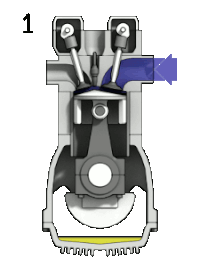
Photo from wikipedia
Abstract This paper deals with the experimental analysis and numerical simulation of a two-phase closed thermosyphon (TPCT) in the aim to predict its transient performances. A concern in the design… Click to show full abstract
Abstract This paper deals with the experimental analysis and numerical simulation of a two-phase closed thermosyphon (TPCT) in the aim to predict its transient performances. A concern in the design and operation of the TPCT is evaluating working fluid loading charge to maximize performance while avoiding dryout in the evaporator section and geyser boiling phenomena. The model includes the heat transfer through the wall, the vapor core, the liquid pool and the falling condensate film. The complete two-dimensional conservation equations for mass, momentum, and energy are solved using a finite volume scheme for the vapor flow and the pipe wall. The liquid film is modeled by using one-dimensional quasi-steady Nusselt type solution. An experimental facility has been also designed and operated to determine the operating condition and measure the maximum heat transfer rate and the overall thermal resistance of the TPCT. The total length and the diameter of pipe are 500 mm and 35 mm, respectively. The experiments have been performed in the heat transfer range of 30–700 W and filling ratios of 16, 35 and 135%. The numerical predictions for the maximum heat transport rate due to the transient local dryout are shown to be in close agreement with the experimental results under normal operation. However, for obtained liquid film dryout a discrepancy is observed. The geyser boiling is also evaluated under certain operating condition.
Journal Title: Experimental Thermal and Fluid Science
Year Published: 2017
Link to full text (if available)
Share on Social Media: Sign Up to like & get
recommendations!